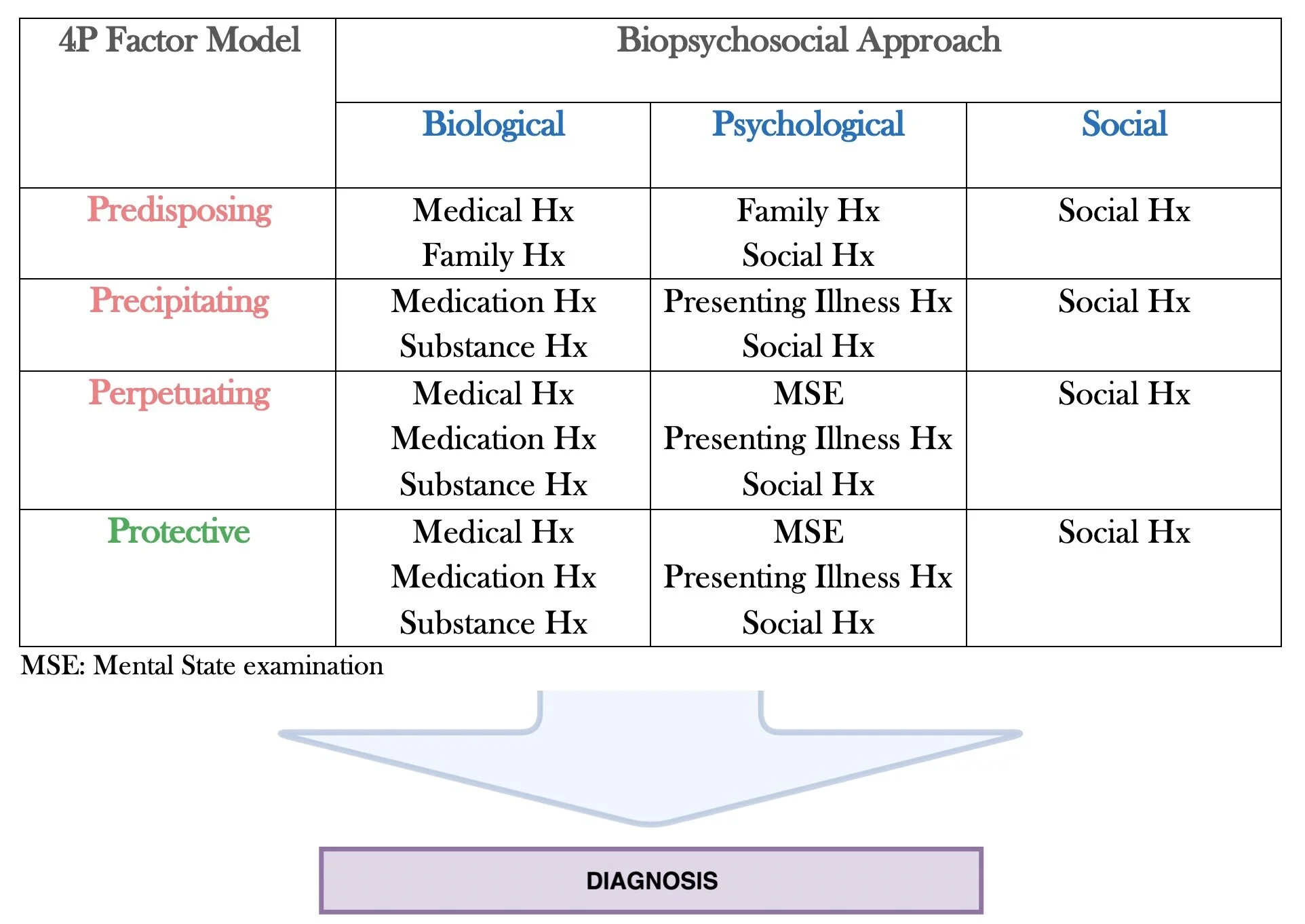The 4P Factor Model and Its Purpose in Psychological Medicine.
Introduction
The 4P factor model formulation, just like the Mental State Examination (MSE), is a tool used in psychology, psychiatry, psychological medicine or whenever it is deemed necessary and useful. It is quick, easy-to-use and is a structured method to describe, assess and observe your patient’s narrative into a coherent and concise record. Unlike the MSE which focuses on the psychological functioning and mental state of your patient, the 4P factor model formulation focuses on the collateral information of your patient and how they got to this point. This involves the past and the present of your patient where generally the MSE is more involved in the ‘now’. In other words, the 4P factor model formulation utilises four types of influences and the biopsychosocial risk factors. These influences and biopsychosocial risk factors shape the progression and development of mental health disorders for a particular patient.
In a nutshell: “The formulation asks what is wrong, how it got to that way, and what can be done about it” (1).
At the end of the 4P factor model formulation, you should have a relatively detailed description of key aspects of your patient’s narrative, what is going on in their lives and their risk factors. The 4P factor model formulation works hand in hand with the MSE; hence if you do both, you would a get a clear picture about your patient’s past and current life, and about their psychological functioning and mental state. This would allow the clinician to make a sound diagnosis, follow-ups, formulations and patient management for recovery. This includes the best course of action such as which therapy is needed, if medication needs to be started, if there is a need for referrals to certain support groups or specialist and so on. These are very useful in psychological consultation, so be sure to study and practise for a seamless and successful consultation!
Check out my other blog in psychology relating to the 4P Factor Model formulation “The Mental State Examination and Its Purpose in Psychological Medicine”.
How is the 4P factor model formulation set up?
Before we get into the risk factors of the 4P factor model formulation, we need to describe how the table is set up. In the table below, the columns contain the biological, psychological and social risk factors all under as the biopsychosocial approach. The rows contain the predisposing, precipitating, perpetuating and protective factors which are under the 4P factor model. That way, the core of the table is divided into 12 squares/boxes. All 4P factor model formulation tables will be unique to their allocated patient.
Table 1. 4P Factor Model Formulation Table
What are the risk factors?
We first need to describe what a risk factor is. Risk factors are positively associated to increase the likelihood of the development and progression of a specific mental health disorder but are not sufficient to cause the disease. These can be through particular events or characteristics. These risk factors can be specific or non-specific and can be with or without adverse childhood events (ACEs). Identifying these risk factors can aid the clinician for a diagnosis, formulation and treatment planning. Each risk factors can have a direct or indirect impact on a patient mental wellbeing, and each patient’s risk factor is experienced differently. It is also important to note that the more risk factors and ACEs a patient has, the more the likelihood of developing a mental disorder.
What are the components of the Biopsychosocial Approach?
Image depicting the Biological, Psychological and Social risk factors.
Biological
Biological generally talks about what the patient has already or was born with such as the unmodifiable factors. This involves their physical development, their genetics or how prone they are to develop any diseases or comorbidities and so on. For example, it is proven that an underweight newborn baby has an increased cardiovascular risk (2). Can that person do anything about that? Well sure (only through modifiable factors as he/she must be careful about their diet, be more exercise conscious, drink less alcohol, not start any sort of smoking et cetera) but the point is that they already start with a disadvantage. The opposite can be said. Natural intelligence, resisting a particular disease or being naturally resilient are protective factors. Hence, biological factors increase or decrease risks, and must be carefully explored as it plays a vital role in how soon a mental disorder may start and how well a patient can cope with their disorder.
Genetics
Family history
Physical development
Intelligence
Temperament
Medical comorbidities
Psychological
This section focuses more on the person and their mind. How is the person doing mentally or psychologically? The psychological aspect describes how you perceive yourself, your confidence, stress, self-esteem, and so on. How is their personality? Look at the development of their emotion, their coping and defence strategies against particular events. How do they respond to stressors?
Personality
Emotional development
Coping-strategies
Self-esteem
Insight
Defence
How to respond to stressors
Patterns of behaviour and cognition
Social
Finally, social is about their connectedness with the community and the world. This includes family and friends, where they live, support from people/friends and human interactions. How does a person fit in society with their culture or religion? Do they feel they belong and contribute to society?
Family and peer relationships
School
Neighbourhoods
Culture
Religion
Socioeconomic status
What are the components of the 4P Factor Model?
Predisposing: Why me?
These are the features that render a person vulnerable to the presenting symptoms. This can include medical and psychiatric history, family history, temperament genetics and chronic social stressors. The predisposing risk factors increase the likelihood of a patient to develop a certain mental health disorder but do not guarantee it. What has let up to this point? What factors have been contributed to this patient’s problem over their life? For example, predisposing under biological can be the previous example on the underweight newborn having a higher cardiovascular risk. The predisposing risk factors do get a little tricky with psychological and social but for psychological you can look, for example, at the patient’s attachment as a child.
Example: family history of physical illness, mental disorder (such as schizophrenia), genetics.
Precipitating: Why now?
Precipitating is usually about what has brought them here today or why is the patient coming to see you? What has made them take the decision to come? Something must have triggered the patient to decide that it was time to make an appointment and see the clinician. Reasons could be from current symptoms, concurrent illness, onset or exacerbation of illness, behavioural response, the role of inciting event and so on. Hence, there has been an increase in the susceptibility of a mental health disorder.
Example: bullying, catastrophic event (bush-fires, flooding, pandemics), increase level of stress.
Perpetuating: Why does it continue?
These are the current things that are making the patient’s condition endure as symptoms may progressively become worst. These could be the severity of their condition, compliance issues, unresolved predisposing and perpetuating factors. In other words, perpetuating maintains the concurrence of a specific mental health disorder and prevents its recovery.
Example: abusive relationship, substance abuse, unsupportive environment, continuing physical or mental illness, unresolved precipitating such as ongoing bullying.
Protective: What can I rely on?
The protective factors can reduce and prevent the occurrence and reoccurrence of a mental health disorder. The protective factors can be the patient’s strength, resilience and support in their lives or the amount of support they have with their family and social groups.
Example: not using substances that would cause a reoccurrence of a mental health disorder, resilience, self-esteem, firm support, education/intelligence, healthy habits, financial stability.
An example of what it should look like
Table 2. Demonstrates the allocated investigations per square/box
This table has been based and modified from PsychDB’s table.
Table 3. Demonstrates examples of what could be found per square/box
Case study: Jane Doe
Use the 4P factor model formulation and delegate this case study to each square/box in the table. This is a fictitious case as I tried to add something to each square just to demonstrate how the 4P factor model would look like.
Jane presents to the GP with what she suspects another depression episode as she has been in a low mood lately. Before that, she has been content with her life. The GP she has been seeing for the last 20 years is not here at the moment so she comes to you. She has been diagnosed with depression 5 years ago and she has been going to counselling groups and is particularly satisfied with how well she handled it. She feels she has recovered from her depression.
Jane is 83 years old. Her daughter, Samantha, lives in the same town, but she rarely gets to see her as she is very busy with her work and family. Samantha has 3 children and every now and then when she can, she visits Jane at her house with her children. Jane also has a son, Jimmy, who lives 3 hours away from her. He tries to visit as often as he can, which is about every month.
You look into her past social history and notice that Jane has been to the university that was in another state and obtained a Bachelor of Economics Cum Laude. Other than that, she has been living in the town for quite a while and has made some strong connections.
Jane is receiving pension funds and she feels it is enough to make a living off it. Jane lives by herself in the house she has had for over 30 years. Jane lives alone as her husband Thomas has been put into a nursing home for about 3 years. Unfortunately, Thomas has Alzheimer’s disease and had to go to the nursing home since Jane couldn’t keep up and care for Thomas.
You decided to ask Jane about her typical day. She says that she sleeps until 6 am as she describes herself as an early bird and then makes herself breakfast. She then reads the paper and likes to do the crosswords and sudoku puzzles. She mentions that her days are always full and that there are always things to do. Occasionally she goes and visits Thomas to play the piano. Jane enjoys walking on Saturday to the park to meet with some knitting friends. On Tuesdays, she visits her sister, Anna, where they catch up on events. She also gets involved with her local church. Lately, Jane has been finding it difficult to do things such as cooking as she hasn’t been very hungry for the past week. She also has skipped going to church in the past 2 weeks.
You look into the past medical history and notice that 3 weeks ago Jane was diagnosed with a stomach ulcer as well as minor kidney damage. Other than that Jane has good health with minor presentations. Whilst talking to her, she mentions that she is worried and concerned about her ulcer and that on some days it just keeps hurting her around the belly. She mentions that the pain is ongoing with a pain scale of 3/10 when she forgets to take her medication. When taking her proton pump inhibitors and her antacids she says it relieves her of her pain. In talking further with Jane, she is tearful when she talks about Thomas and ‘it is not what he used to be’. Unfortunately, Thomas has been deteriorating in the past month with his condition and Jane has been visiting 5 times a week around lunchtime so that she makes sure he is eating all the available food.
You dig deeper whilst talking to Jane and she is stating that she is feeling more and more isolated and lonely at home. Lately, doing the chores around the house has been difficult. Jane just wants to feel better and wants to be treated or referred to more counselling.
You did the Mental State Examination (MSE) and finds that she has good hygiene, unremarkable speech, normal logical thoughts, no hallucination and that she is alert and orientated.
Write down the 4P factor model formulation table and try to allocate each event to each box as best as you can. If this is your first time, just remember roughly what each box stand for and think if the description would match. Did you manage to fill all the boxes correctly? Was there any overlapping description that you felt should go into more than one box? Sometimes the same description can be repeated in a different box. The crux is as long as you can back-up your thinking into the allocated box, then it should be fine as there are many presentation styles. Remember, there is no right or wrong way to present the 4P factor model formulation. It should be intuitive and flow logically. Do note that sometimes some of the squares/boxes might not even be filled at all and that is perfectly fine.
You will learn more about each box and its description as you practice more often. To this date, I have done many formulations on patients and have been quite successful. One thing for sure is that it was helpful for my 5th-year psychiatry rotation.
Conclusion
Remember the 4P factor model formulation is a structured formula to create a quick and thorough detail of your patient’s narrative into a coherent and concise record. Utilising the Mental State Examination (MSE) with the 4P factor model formulation, we can get an even better outlook on your patient’s life as the MSE looks at your patient psychological functioning and mental state. If you notice in table 2, the MSE fills up 2 squares/boxes in the 4P factor model formulation table.
In the end, the 4P factor model formulation along with the MSE allows the clinician to make a sound diagnosis, suggest follow-ups if needed, prepare sound formulations and/or patient management for a successful recovery. This would include the best course of action such as which therapy is needed, if medication needs to be started, if there is a need for referrals to certain support groups or specialist and so on.
Published 30th December 2019. Last reviewed 20th January 2023.
Reference
1. Nurcombe B, Drell M, Leonard H, et al. Clinical problem solving: the case of Matthewhew, part 1. J Am Acad Child Adolesc Psychiatry. 2002;41(1):92–7. DOI: https://doi.org/10.1097/00004583-200201000-00017.
2. Umer A, Hamilton C, Cottrell L, Giacobbi P, Innes K, Kelley GA, Neal W, John C, Lilly C. Association between birth weight and childhood cardiovascular disease risk factors in West Virginia. Journal of Developmental Origins of Health and Disease. 2019;1. DOI: 10.1017/S204017441900045X.
ADDITIONAL SOURCE OF INFORMATION:
Australian Government: The Department of Health. Phase 4: Case formulation. Australian Government: The Department of Health website. https://www1.health.gov.au/internet/publications/publishing.nsf/Content/drugtreat-pubs-cogamph-toc~drugtreat-pubs-cogamph-3~drugtreat-pubs-cogamph-3-1~drugtreat-pubs-cogamph-3-1-4. Published November, 2019. Accessed November 29, 2019.
Bolton J. W. Case formulation after Engel—The 4P model: A philosophical case conference. Philosophy, Psychiatry, & Psychology. 2014;21(3):179-189. https://doi.org/10.1353/ppp.2014.0027. Accessed November 30, 2019.
Jessica Postuma. 4P Presentation. Press website. https://prezi.com/p/qgtuj0lfvysd/4p-presentation/. Updated October 31st, 2017. Accessed November 29, 2019.
PsychDB. Biopsychosocial Model and Case Formulation. PsychDB website. https://www.psychdb.com/teaching/intermediate/biopsychosocial-formulation. Published November, 2019. Accessed November 29, 2019.
Shona Innes. Try ‘4p + 4’ for a fresh approach to complex mental health case formulation & treatment planning. Shona Innes Psychology. http://www.shonainnespsychology.com.au/blog/try-4p-4-for-a-fresh-approach-to-complex-mental-health-case-formulation-treatment-planning. Published April 28th, 2016. Accessed November 29, 2019.
Susan Ayers, Richard de Visser. Psychology for Medicine. 1st ed. London: SAGE Publication Ltd; 2011. ISBN: 978-1-4129-4690-2.





































